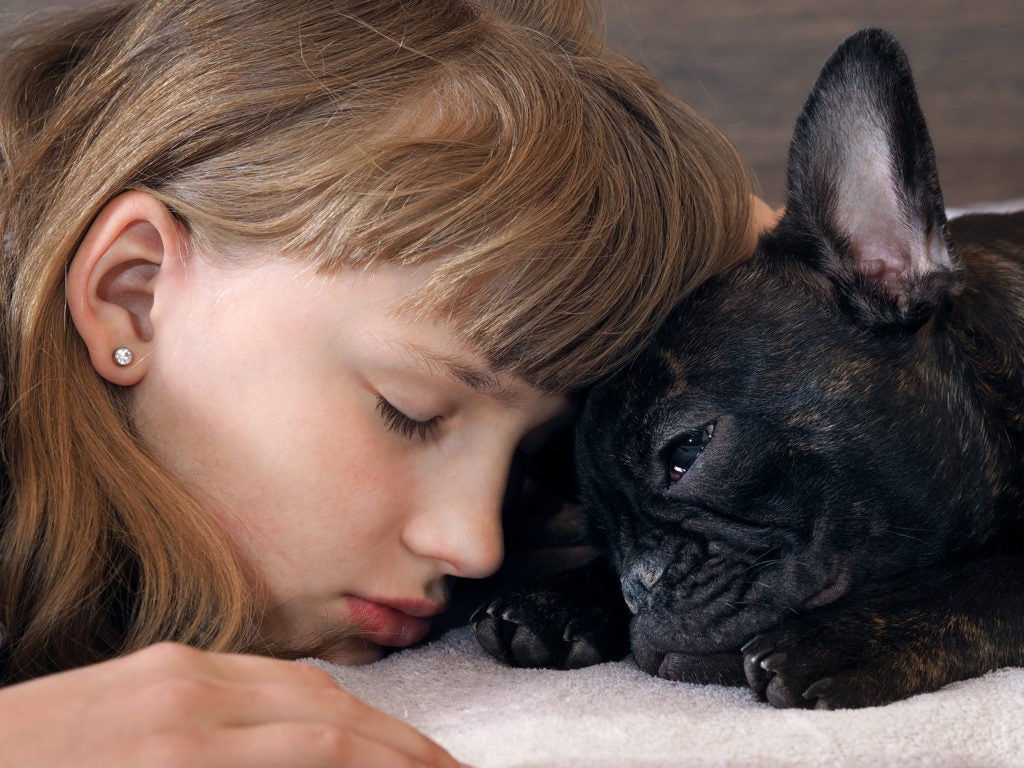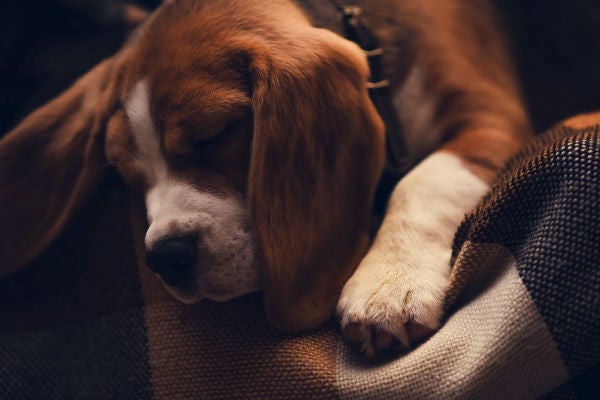
What do dogs dream about? Is your snoozing hound merrily tracking the scent of rabbits across a meadow, or is your tuckered-out terrier just twitching in their sleep? Do dogs dream the same way people do? Do our dogs dream about us? Their favorite toys or treats? We have so many questions. While it’s impossible to have all the answers on what dogs might dream about, scientists are digging in to the data behind dog sleep cycles and dreaming, which brings us one step closer to understanding our pets.
The Science Behind Dog Dreams
Humans don’t have a monopoly on dreams. In fact, scientists believe that most vertebrates, and maybe even the humble fruit fly, can–and do–dream on a regular basis.
Like people, dogs and other animals go through several sleep cycles. There are periods of wakefulness, followed by rapid eye movement (REM) sleep, and non-rapid-eye-movement sleep. REM sleep is the period when the most memorable and vivid dreams happen, and it’s believed to be a part of how the body processes memory. Scientists can track sleep cycles in people and other animals, and their associated brain activity, using specialized equipment.
One of the most famous of these dream experiments involved lab rats. Rats in the experiment spent all day running in a maze. Scientists monitored the brain activity of the rats in the maze and compared it to the brain activity of the rats during REM sleep. What they discovered was that the same areas of the rats’ brains lit up during REM sleep as when they were running the maze, suggesting that the rats were likely to be dreaming of the maze. By comparing the data, the researchers could figure out where exactly in the maze the rats were dreaming about.
This suggested to the researchers that animals tend to dream in the same way that people do. The rats dreamed about what they did during the day, just like you might find yourself dreaming about being at work (even if you would rather dreamed about something more exciting). Researchers at the Massachusetts Institute of Technology concluded that animals have complex dreams, and they can remember and replay long sequences of events when they are asleep.
The National Sleep Foundation reports that dogs spend about half their day sleeping. For puppies, senior dogs, and larger breeds, time spent sleeping can take up even more of their day.

What Do Dogs Dream About?
Most dogs lead more interesting lives than rats. To figure out what dogs might dream of, researchers performed a test that temporarily disabled the pons.
If, like me, you’d never heard of the pons before this, let me explain. The pons is the part of the brain stem that is involved in the control of sleep cycles and the regulation of deep sleep and is responsible for inhibiting your large muscles from moving during sleep. In other words, you can thank the pons for preventing your partner from flailing around during dreams and waking you up. Without the pons, we might act out everything we were dreaming about — probably with disastrous results.
You may have noticed that puppies and older dogs twitch and move a lot in their sleep. This is because the pons is underdeveloped in puppies and less efficient in older dogs, according to Stanley Coren, a professor emeritus of psychology at the University of British Columbia. The same is true for human infants and older adults.
Researchers figured out that one of the ways to discover what dogs might dream about is to temporarily disable the pons during REM sleep. This allowed them, under carefully controlled conditions, to let the dogs act out their dreams.
The results were pretty much what we’ve all suspected for years.
“What we’ve basically found is that dogs dream doggy things . . . The dream pattern in dogs seems to be very similar to the dream pattern in humans,” according to the researchers.
Does the Dog’s Breed Affect Dreams?
People vary as to how often they dream and what they dream about, and researchers believe that is true of dogs, as well. Coren reports that small dogs have more frequent dreams than large dogs, but those small dog dreams are shorter in duration. Large dogs, on the other hand, have fewer, but longer dreams.
We can also hazard a guess that what your dog does all day determines his dreams. While we can’t yet be sure, the fact that Pointers point and Dobermans display guard behavior implies that breed-specific activities may take place during dreams, too. Your Labrador Retriever, for instance, is more likely to dream about chasing tennis balls than is a Pug.
Do Dogs Have Nightmares?
Not all human dreams are good. We infer that dogs can have nightmares, too. These nightmares are hard to watch. It can be tempting to wake your dog to comfort her, as you would a child, but there are some risks associated with doggy nightmares that you should share with your family.
If you’ve ever been woken from a scary dream, you know that it can take a minute to remember where you are and whom you are with. Like some people, dogs can react aggressively toward the person waking them. This can be dangerous, especially for children. The best thing that you can do for a dog you think is having a bad dream is to wait for your dog to wake up and be there to comfort him, following the old saying “let sleeping dogs lie.”

What Is My Dog Dreaming About?
There is no way for us to know exactly what makes up the stuff of our dogs’ dreams, but we might be able to guess.
Observe your dog during sleep to see what he does. REM sleep typically begins 20 minutes into a nap and lasts for two-to-three minutes. This is when you might notice your dog twitching or making sounds. Are there any similarities between your dog’s actions during REM sleep and his daily activities?
My dog, for instance, does a lot of running in her sleep. Her paws are always twitching, and her lips move. Is she chasing something? Playing with a doggy friend? Chasing an intruder? Or simply running down her tennis ball in a big, open field? I don’t know the details, but since these are her favorite things to do while awake, I am pretty sure she dreams about them.
Sometimes, our dogs give us even more clues. In an interview with a Harvard psychologist, one owner reported that he suspected his dog had recently had a nightmare about bath time. This dog did not like baths, and when the bath was over, he always ran to the owner and hid between his legs. He did not perform this behavior any other time. One day, the owner observed his dog having a dream. When the dog woke up, it bolted and hid between his legs, leading the owner to conclude that the dog had just had a scary dream about his bath.
No matter what our dogs dream about, there is some comfort in believing that they, like us, have dreams and fears that play out in their sleep, making us more alike than different.

